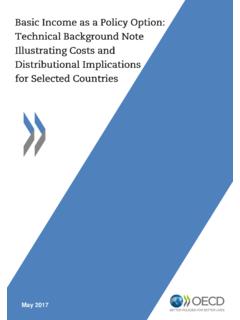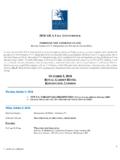Transcription of VAT on Vouchers uK g c explAined Voucher A
1 UK Gift Card& on Vouchers explAinedVoucher definiTionThe UK VAT legislation defines a face value Voucher as follows: face-value Voucher means a token, stamp or Voucher (whether in physical or electronic form) that represents a right to receive goods or services to the value of an amount stated on it or recorded in chAnges To The VAT TreATmenT of fAce VAlue Voucherssingle or mulTi purpose Voucher ?From May 2012, the concept of a single purpose Voucher ( SPV ) was introduced into UK legislation. This affects all SPV s whether credit, retailer or other types of current UK VAT legislation a single purpose face value Voucher is one that carries the right to receive goods or services of one type which are subject to a single rate o f an example a prepaid telephone card that can only be used for making telephone calls in the UK would fall under the scope of an SPV (as all calls would be liable to UK VAT), however a retailer Voucher that could be redeemed at a store that sells goods at different VAT rates (for example a children s t-shirt (zero rated) or an item of furniture (standard rated)) would not fall under the definition of an SPV.
2 If it was redeemable for different types of goods liable at the same rate ( furniture and clothes) it would also not be an previous rules disregarded the supply of face value Vouchers when issued and VAT was brought to account on redemption. However, under the new rules, if a Voucher is an SPV then VAT due on the SPV must be brought to account on an SPV is sold both initially and by retailers or distributors, it is treated as a supply of the goods or services for which it can be redeemed. This applies whether the Voucher is issued by the person from whom it can be redeemed or by a third telecommunications company produces Vouchers that entitle the holder to 10 worth of telephone calls which can only be made in the UK.
3 It sells the Voucher to a distributor for 8 and the distributor sells the Voucher to a retailer for 9 the retailer then sells the Voucher to the final consumer for telecommunications company sells the Voucher to a distributor for 8 and accounts for VAT on the 8. The distributor recovers the input tax and sells the Voucher to a retailer for 9 and accounts for VAT on 9. The retailer recovers the input tax and sells the Voucher to the final consumer for 10 and accounts for output tax on redemption, no VAT is due as VAT has already been brought to account on reality, the vast majority of face value Vouchers will not meet the current UK definition of an SPV and as such will be defined as a Multi Purpose Voucher (MPV).
4 Eu direcTiVe on The VAT TreATmenT of VouchersIn 2012, the EU commission published a proposal for changes to the VAT treatment of Vouchers (on the basis that there is no current EU wide legislation covering Vouchers ). The EU Draft Directive also introduced the concept of an SPV and MPV (as per current UK legislation), however the EU s current proposed definition of an SPV is different to that in the current UK legislation. Under the draft EU directive, an SPV is one where the redeemer, the VAT rate and the place of supply is known at the point of issue. Any Voucher that can be redeemed by more than one party is an MPV under EU legislation as is any Voucher which can be redeemed for goods of more than one rate or in more than one country.
5 The concept of a retailer and credit Voucher is not present in the EU EU commission is also currently looking to agree the process of how VAT will be accounted for throughout the supply chain. the EU directive is approved and an implementation date confirmed, the UK legislation will need to be further amended to take into account the EU revised VAT treatment of Vouchers throughout the supply chain. mulTi purpose Vouchers currenT uK VAT rulesFor MPVs the current UK VAT treatment of face value Vouchers has not materially altered since 2003 and the following rules apply: reTAiler VouchersThese are face value Vouchers where the Voucher can be redeemed by the issuer (or a third party). The consideration for the issue of a retailer Voucher is disregarded except to the extent that it exceeds the face value.
6 VAT is accounted for at the time the Voucher is redeemed for goods or services on the value for which the Voucher was initially supplies of a retailer Voucher , following the first supply by the issuer, are not disregarded and are taxable on issue. This is explAined further VouchersA credit Voucher is defined as a face value Voucher that is issued by a person who cannot redeem the Voucher for goods or services themselves. Instead, they undertake to give complete or partial reimbursement to the person who does redeem the Vouchers for goods and for all supplies of credit Vouchers is disregarded for VAT purposes except to the extent that it exceeds the face value. The redeemer of the Voucher accounts for VAT at the time the Voucher is redeemed for goods or services.
7 However, to qualify for this treatment, the redeemer must account for VAT on the full face value of the implications for Voucher proViders reTAiler VouchersWhenever a retailer Voucher is sold to a company which is VAT registered, the Voucher provider should issue an invoice which shows the amount of VAT charged, which is included in the sale price of the Vouchers . VAT should normally be charged at the standard rate (20%) unless it is known that the Voucher can be redeemed for zero-rated or reduced-rated goods, or unless the retailer has, and is prepared to disclose, a composite rate (This will likely be the case on the basis that the Vouchers are MPVs). Many retailers have an agreed composite rate with HMRC which averages out the range of standard-rated, reduced-rated and zero-rated goods that the retailer sells.
8 These rates can be passed through the supply chain, if the Voucher provider states its composite rate on a VAT invoice when supplying Vouchers . However, retailers still do not have to account for this VAT until the Voucher has been redeemed. Therefore some issuers are producing documents which serve as VAT invoices for their customers but which do not lead to VAT being accounted for through the accounts system for the issuer of the Vouchers . ExampleA retailer sells its own Vouchers to a VAT registered business customer. The total face value of the Vouchers is 10,000 and the Vouchers are sold for 9, retailer should issue an invoice for 9,500 (inclusive of VAT) and the VAT should be accounted for on the net value of 9,500 at 20% or at a composite rate if this is stated.
9 In short, the customer pays 9,500, inclusive of VAT. So based on 20% VAT, net purchase value would be 7, , with VAT of 1, The issuer should state the following on the invoice the issuer of the Vouchers will account for tax under the face value Voucher provisions in Schedule 10A VAT Act 1994. VAT implications for Third pArTiesVAT implications for Third pArTy inTermediAries When the intermediary purchases the Vouchers , it can recover the VAT as Input Tax, subject to normal VAT rules and at the rate shown on the invoice. The tax point is the date on the invoice and the intermediary can recover VAT as at this date. When the intermediary sells the Vouchers on to a corporate customer, it should raise a VAT invoice for the amount at which the Vouchers are sold in other words, including any margin set by the intermediary.
10 VAT should be set at the same rate as that provided by the issuer. This means that if the retailer has a composite rate, this flows through to the onward sale of the Voucher . If the intermediary is selling onto another supplier, then they must provide a full VAT invoice, inclusive of VAT at the amount the Voucher is sold intermediary buys retailer Vouchers with a face value of 10,000 for 9,500. It can recover the VAT as Input Tax on the 9,500 at the composite rate if stated by the retailer, or at 20% if no composite rate is stated. It then sells all the Vouchers to a corporate customer for 10,000. At this stage the intermediary should issue a VAT invoice for 10,000 (inclusive of VAT). If the composite rate is known, it should be stated on the implications for corporATe cusTomers Where a corporate customer purchases a Voucher as a gift for an employee, customer or client, it can recover the Input Tax, subject to normal VAT rules.




